Electrochemical Corrosion Behavior of Near-Nano and Nanostructured WC-Co Cemented Carbides
Abstract
:1. Introduction
2. Materials and Methods
Electrochemical Measurement
3. Results
4. Analysis and Discussion
4.1. Potentiodynamic Polarisation Behaviour, DC Techniques
4.2. EIS Analysis
5. Conclusions
- (i).
- The consolidation process contributed to electrochemical corrosion resistance; better corrosion resistance was observed for samples consolidated by sintering in hydrogen, even though the densities of samples are lower compared to sinter-HIPed samples, excluding the sample with a high degree of porosity and cracks on the surface.
- (ii).
- Grain growth inhibitors in the starting powders influenced the electrochemical corrosion resistance; samples with only 0.27% VC showed better corrosion resistance compared to samples with an addition of 0.26% VC and 0.45% Cr3C2. The combination of VC and Cr3C2 leads to lower corrosion resistance.
- (iii).
- The size of the starting powder and amount of GGIs influenced the electrochemical corrosion resistance; samples consolidated by 150 nm WC showed better corrosion resistance compared to samples consolidated by 95 nm WC powder.
- (iv).
- η-phase changes the electrochemical behaviour; enhances the formation of a passive layer on the samples' surfaces, thereby reducing the tendency of the sample dissolution and increasing the stability of oxides forming therewith a passive layer on the sample surface. In order to define an influence of η-phase on the electrochemical corrosion behaviour of nanostructured cemented carbides, more detailed research which includes XRD analysis and magnetic saturation is planned in the future research.
- (v).
- The samples with lower Co content showed better corrosion resistance, confirming a selective leaching of the Co in neutral media.
Author Contributions
Conflicts of Interest
References
- Hochstrasser-Kurz, S. Mechanistic Study of the Corrosion Reactions on WC-Co Hardmetal in Aqueous Solution—An Investigation by Electrochemical Methods and Elemental Solution Analysis; Shaker Verlag: Aachen, Germany, 2006. [Google Scholar]
- Hochstrasser-Kurz, S.; Mueller, Y.; Latkoczy, C.; Virtanen, S.; Schmutz, P. Analytical characterisation of the corrosion mechanism and inductively coupled plasma mass spectroscopy. Corr. Sci. 2007, 49, 2002–2020. [Google Scholar] [CrossRef]
- Sandvik: Cemented Carbide, Sandvik New Developments and Applications. Available online: http://www2.sandvik.com/sandvik/0130/HI/SE03411.nsf/7a5364adb7735b05412568c70034ea1b/651f6e334db04c46c125707600562c88/$FILE/Cemented+Carbide.pdf (accessed on 25 April 2015).
- Human, A.M.; Exner, H.E. Electrochemical behavior of tungsten-carbide hardmetals. Mater. Sci. Eng. 1996, A209, 180–191. [Google Scholar] [CrossRef]
- Human, A.M. The Corrosion of Tungsten Carbide-Based Cemented Carbides. Ph.D. Thesis, Technische Hochschule Darmstadt, Darmstadt, Germany, 1994. [Google Scholar]
- Tarrago, J.M.; Fargas, G.; Jimenez-Pique, E.; Felip, A.; Isern, L.; Coureaux, D.; Roal, J.J.; Al-Dawery, I.; Fair, J.; Llanes, L. Corrosion damage in WC–Co cemented carbides: Residual strength assessment and 3D FIB-FESEM tomography characterization. Powder Metall. 2014, 57, 5. [Google Scholar] [CrossRef]
- Sacks, N. The Wear and Corrosive-Wear Response of Tungsten Carbide-Cobalt Hardmetals under Woodcutting and Three Body Abrasion Conditions; Faculty of Engineering of the University of Erlangen-Nürnberg: Doktor-Ingenieur, Germany, 2002. [Google Scholar]
- Zhang, L.; Wan, Q.; Huang, B.; Liu, Z.; Zhu, J. Effects of WC Grain Sizes and Aggressive Media on the Electrochemical Corrosion Behaviours of WC-Co Cemented Carbides. In Proceedings of the EURO PM2015-HM-Modelling and Characterisation, Reims, France, 4–7 September, 2015.
- Tarrago, J.M.; Fargas, G.; Jimenez-Pique, E.; Dorvlo, S.; Llanes, L. Influence of Carbide Grain Size on the Corrosion damage in WC-Co cemented carbides: Electrochemical Measurement, residual strength and 3D FIB/FESEM characterisation of Induced Damage. In Proceedings of the World PM2016, Hamburg, Germany, 9–13 October 2016; pp. 509–514.
- Sutthiruangwong, S.; Mori, G. Influence of refractory metal carbide addition on corrosion properties of cemented carbides. Mater. Manuf. Proc. 2005, 20, 47–56. [Google Scholar] [CrossRef]
- Sutthiruangwong, S.; Mori, G. Corrosion properties of Co-based cemented carbides in acidic solutions. Int. J. Refract. Metals Hard Mater. 2003, 21, 135–145. [Google Scholar] [CrossRef]
- Mori, G.; Zitter, H.; Lackner, A.; Schretter, M. Influencing the Corrosion Resistance of Cemented Carbides by addition of Cr2C3, TiC and TaC. In Proceedings of the 15th International Plansee Seminar, Plansee Holding AG, Reutte, Austria, May 2001; Volume 2.
- Aleksandrov Fabijanić, T.; Alar, Ž.; Ćorić, D. Influence of Consolidation Process and Sintering Temperature on Microstructure and Mechanical properties of Near Nano- and Nanostructured WC-Co Cemented Carbides. Int. J. Refract. Metals Hard Mater. 2016, 54, 82–89. [Google Scholar] [CrossRef]
- Fabijanić, T.A.; Jakovljević, S.; Franz, M.; Jeren, I. Influence of Grain Growth Inhibitors and Powder Size on the Properties of Ultrafine and Nanostructured Cemented Carbides Sintered in Hydrogen. Metals 2016, 6, 198. [Google Scholar] [CrossRef]
- Majdak, I. Corrosion resistance of nanostructured hardmetals, Faculty of Mechanical Engineering and Naval Architecture, Zagreb, Croatia. Unpublished work. 2016. [Google Scholar]
- Potgieter, J.H.; Olubambi, P.; Potgieter-Vermaak, S.S. The Corrosion Behaviour of WC-Co-Ru Alloys in Aggressive Chloride Media. Int. J. Electr. 2014, 2014, 594871. [Google Scholar] [CrossRef] [Green Version]
- Wentzel, E.J.; Allen, C. The erosion-corrosion resistance of tungsten-carbide hard metals. Int. J. Refract. Metals Hard Mater. 1997, 15, 81–87. [Google Scholar] [CrossRef]
- Tomlinson, W.J.; Ayerst, N.J. Anodic polarization and corrosion of WC-Co hardmetals containing small amounts of Cr3C2 and/or VC. J. Mater. Sci. 1989, 24, 2348–2352. [Google Scholar] [CrossRef]
- Bonjour, C. Effects of ruthenium additions on the properties and machining behaviour of WC-Co hard metals. In Proceedings of the EURO PM2014—Powder Metallurgy Tool Material, Vienna, Austria, 17–21 October 2004.
- Lisovsky, A.F.; Tkachenko, N.V.; Kebko, V. Structure of a binding phase in re-alloyed WC-Co cemented carbides. Int. J. Refract. Metals Hard Mater. 1991, 10, 33–36. [Google Scholar] [CrossRef]
- Ringas, C.; Robinson, F.P.A.; Luyckx, S.B.; Sellschop, J.P.F. Corrosion behaviour of ion implanted WC-Co and WCNi alloys in acid and chloride containing media. Surf. Eng. 1990, 6, 194–198. [Google Scholar] [CrossRef]
- Sutthiruangwong, S.; Mori, G.; Kosters, R. Passivity and pseudopassivity of cemented carbides. Int. J. Refract. Metals Hard Mater. 2005, 23, 129–136. [Google Scholar] [CrossRef]
- Machio, C.N.; Konadu, D.S.; Potgieter, J.H.; Potgieter-Vermaak, S.; van der Merwe, J. Corrosion of WC-VC-Co Hardmetal in Neutral Chloride Containing Media. ISRN Corr. 2013, 2013, 506759. [Google Scholar] [CrossRef]
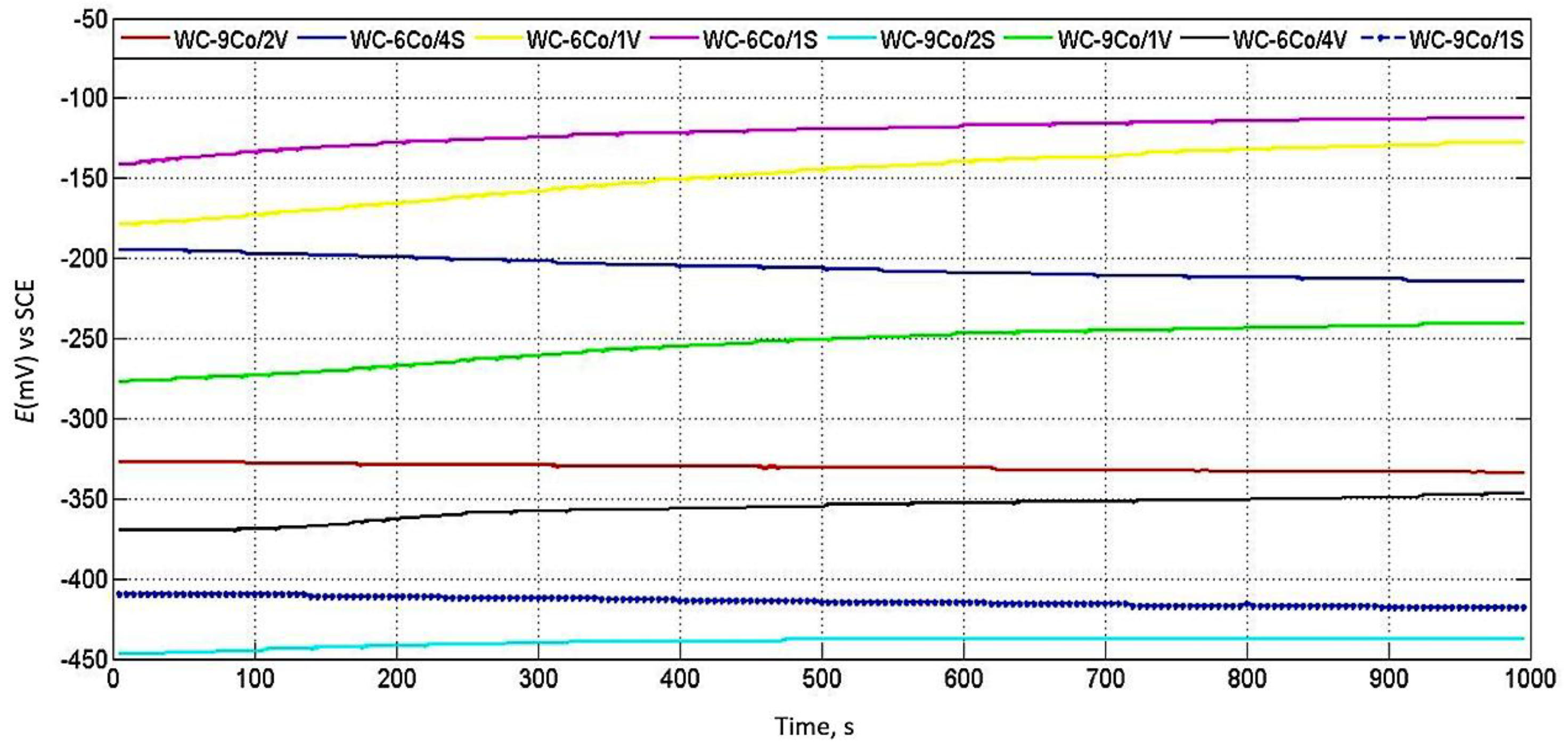
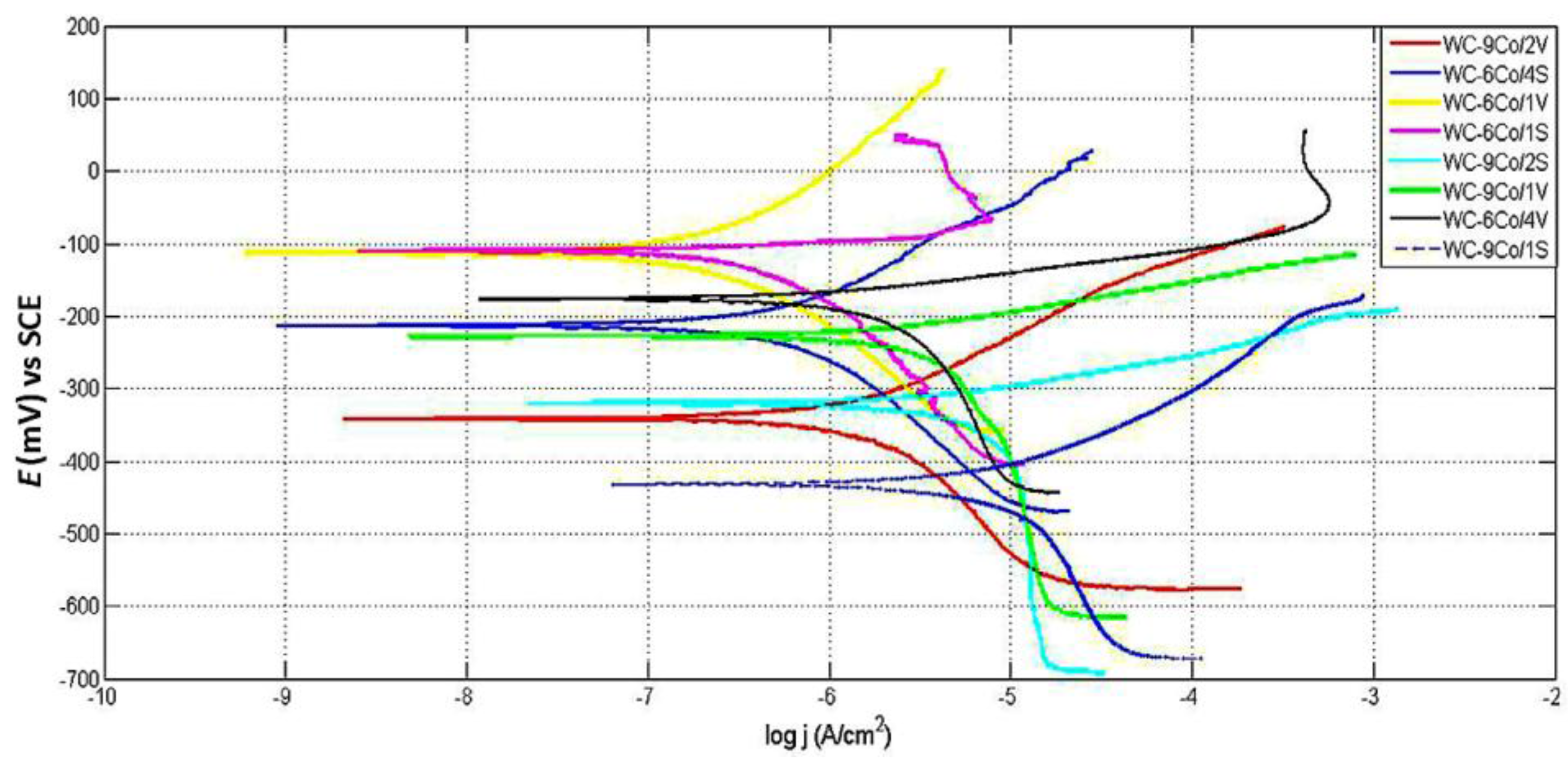
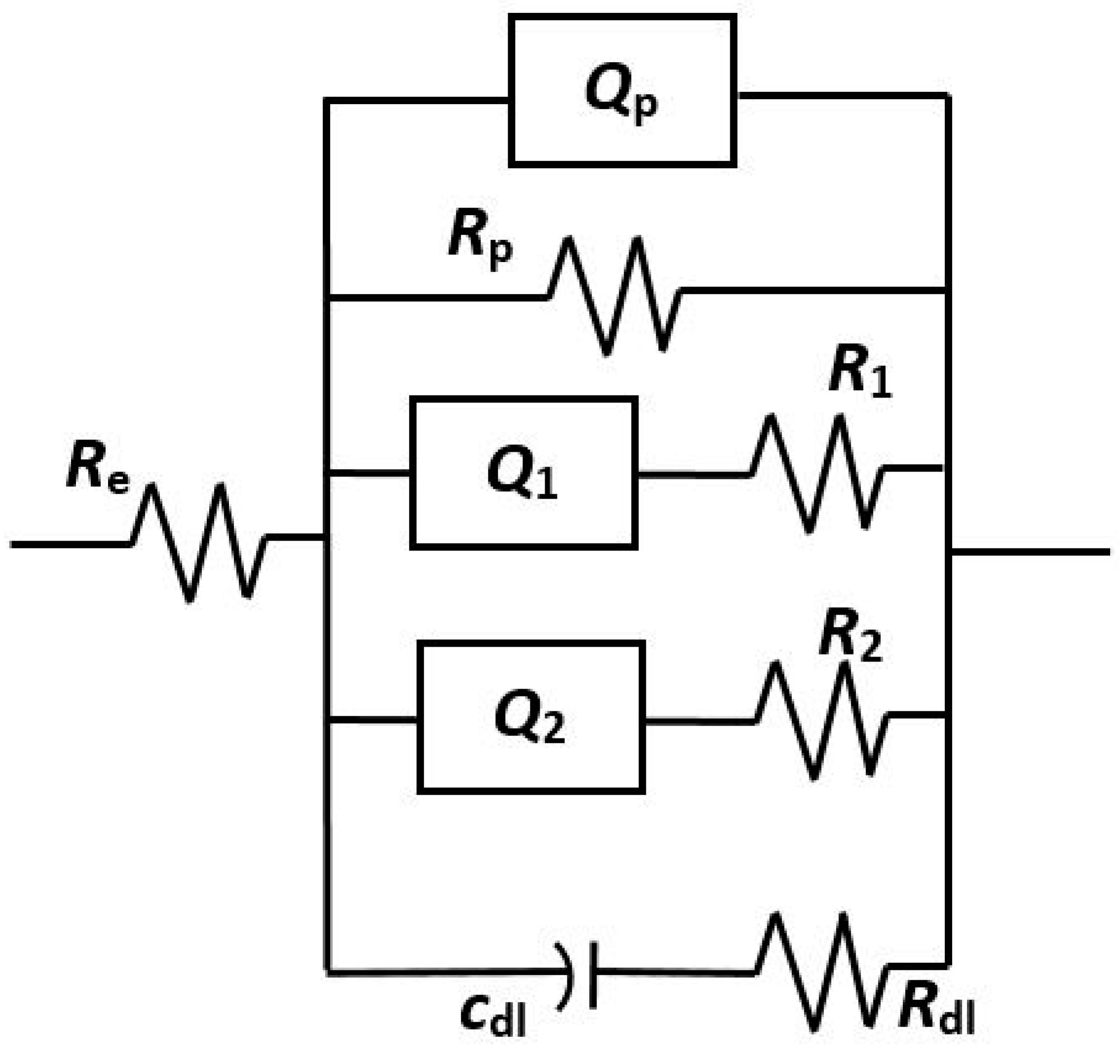
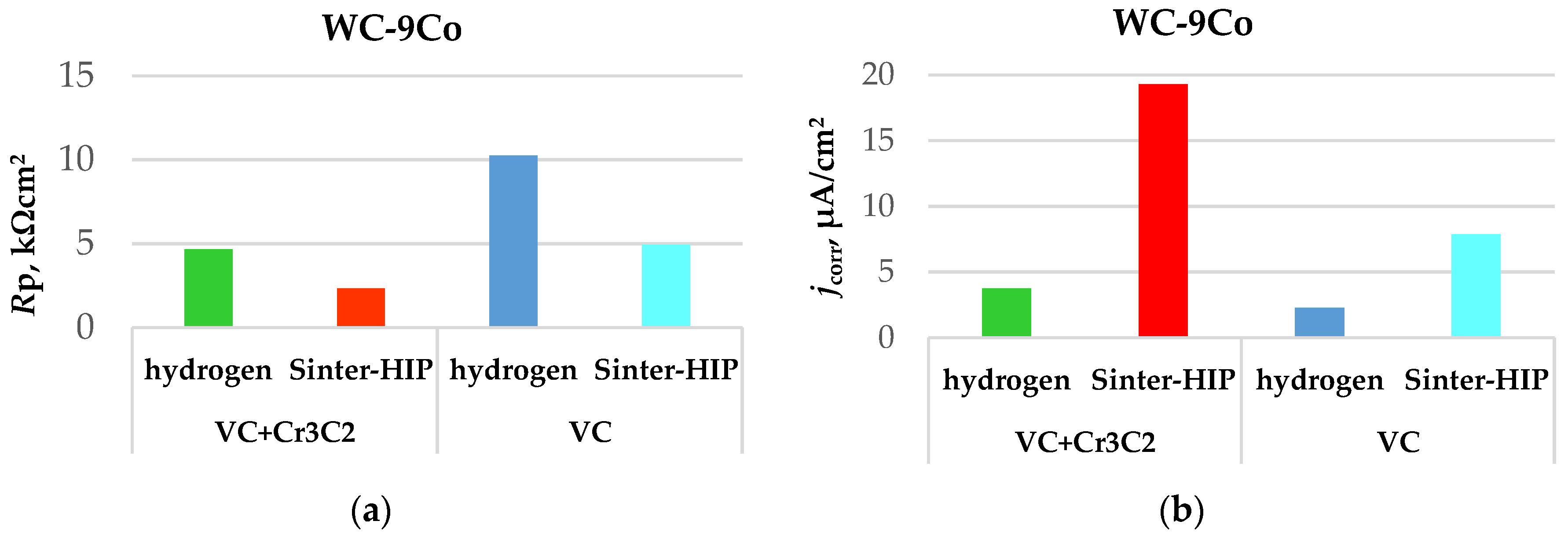

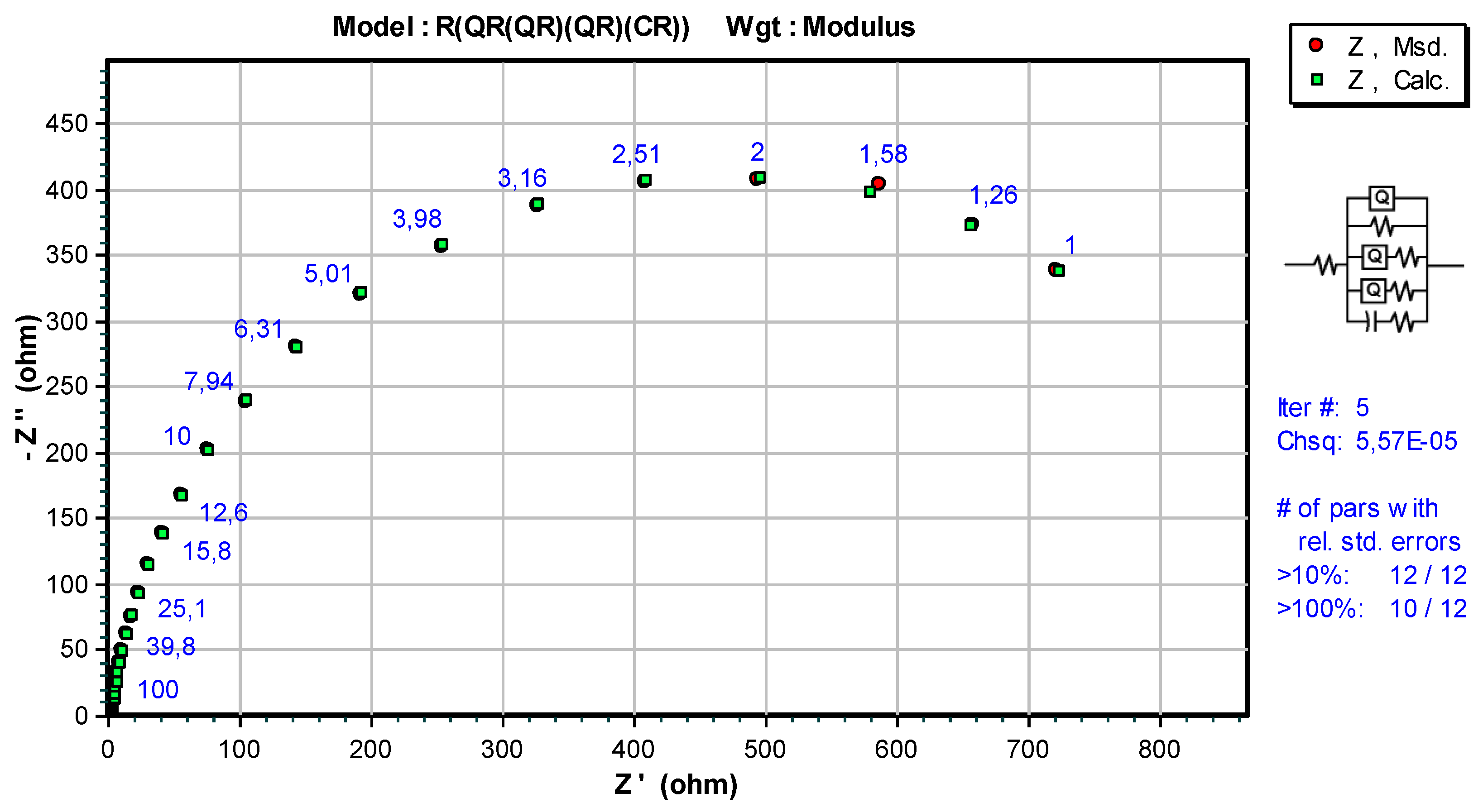

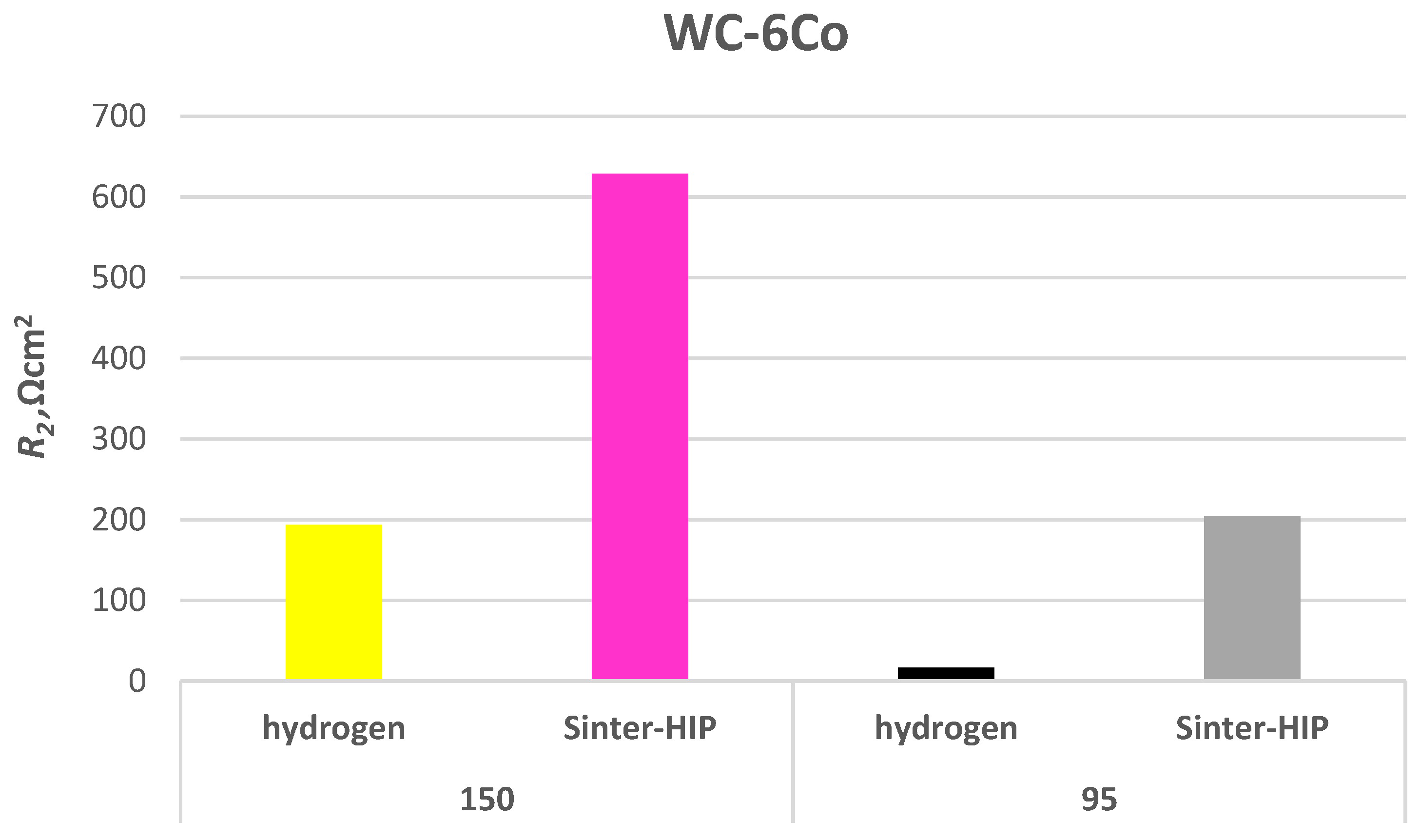
| Mixture | Sample | WC Powder | Grain Size dBET, nm | GGI, wt % | Co, wt % | Sintering Atmosphere |
|---|---|---|---|---|---|---|
| WC9Co/1 | WC-9Co/1V | WC DN 2-5/1 | 150 | 0.26% VC, 0.45% Cr3C2 | 9 | Hydrogen |
| WC-9Co/1S | 9 | Sinter-HIP | ||||
| WC9Co/2 | WC-9Co/2V | WC DN 2-5/2 | 150 | 0.27% VC | 9 | Hydrogen |
| WC-9Co/2S | 9 | Sinter-HIP | ||||
| WC6Co/1 | WC-6Co/1V | WC DN 2-5/1 | 150 | 0.26% VC, 0.45% Cr3C2 | 6 | Hydrogen |
| WC-6Co/1S | 6 | Sinter-HIP | ||||
| WC6Co/4 | WC-6Co/4V | WC DN 4-0 | 95 | 0.41%VC, 0.80% Cr3C2 | 6 | Hydrogen |
| WC-6Co/4S | 6 | Sinter-HIP |
| Mixture | Sample | Porosity | η-phase | dWC, μm | Measured Density, g/cm3 | ρ, % | ||
|---|---|---|---|---|---|---|---|---|
| A | B | C | ||||||
| WC9Co/1 | WC-9Co/1V | A02 | B00, B02 | C00 | N | 0.249 ± 0.122 | 14.45 ± 0.06 | 99.6 |
| WC-9Co/1S | A00 | B00 | C00 | N | 0.192 ± 0.073 | 14.60 ± 0.03 | 100 | |
| WC-9Co/2 | WC-9Co/2V | A02 | B00, B02 | C00 | N | 0.265 ± 0.159 | 14.51 ± 0.05 | 99.4 |
| WC-9Co/2S | A00 | B00 | C00 | N | 0.243 ± 0.086 | 14.66 ± 0.02 | 100 | |
| WC-6Co/1 | WC-6Co/1V | A04 | B02 | C00 | N | 0.235 ± 0.135 | 14.70 ± 0.08 | 99.1 |
| WC-6Co/1S | A02 | B00 | C00 | Y | 0.216 ± 0.078 | 14.82 ± 0.04 | 99.9 | |
| WC6Co/4 | WC-6Co/4V | A06 | B02 | C00 | N | 0.175 ± 0.155 | 14.55 ± 0.08 | 98.6 |
| WC-6Co/4S | A04 | B00 | C00 | Y | 0.139 ± 0.058 | 14.74 ± 0.04 | 99.8 | |
| Sample | Ts (°C) | Ecorr vs. SCE (mV) | Rp (kΩ·cm2) | ba (V/dec) | bc (V/dec) | jcorr (μA/cm2) | vcorr (mm/a) |
|---|---|---|---|---|---|---|---|
| WC-9Co/1V | 20 ± 2 | −241 | 4.66 | 0.0579 | 0.3992 | 3.755 | 0.0678 |
| WC-9Co/1S | 20 ± 2 | −418 | 2.35 | 0.1707 | 1.0180 | 19.310 | 0.3488 |
| WC-9Co/2V | 20 ± 2 | −334 | 10.26 | 0.1593 | 0.2742 | 2.269 | 0.0409 |
| WC-9Co/2S | 20 ± 2 | −438 | 4.94 | 0.0649 | 0.8492 | 7.879 | 0.1419 |
| WC-6Co/1V | 20 ± 2 | −128 | 101.10 | 0.2260 | 0.2014 | 0.352 | 0.0064 |
| WC-6Co/1S | 20 ± 2 | −112 | 71.96 | 0.0275 | 0.1373 | 0.292 | 0.0052 |
| WC-6Co/4V | 20 ± 2 | −347 | 17.55 | 0.0041 | 0.2740 | 1.660 | 0.0030 |
| WC-6Co/4S | 20 ± 2 | −214 | 39.72 | 0.2078 | 0.2718 | 1.065 | 0.0193 |
| Sample | Re, Ω·cm2 | Qp-Yo, S·sn·cm2 | np | Rp, Ω·cm2 | Q1-Y01, S·sn·cm2 | n1 | R1, Ω·cm2 | Q2-Y02, S·sn·cm2 | n2 | R2, Ω·cm2 | Cdl, F/cm2 | Rdl, Ω·cm2 |
|---|---|---|---|---|---|---|---|---|---|---|---|---|
| WC-9Co/1V | 0.002 | 1.6 × 10−7 | 0.99 | 1.2 × 104 | 2 × 10−5 | 0.79 | 63.4 | 1.6 × 10−4 | 0.91 | 12.8 | 1.3 × 10−5 | 35.44 |
| WC-9Co/1S | 11.19 | 2.1 × 10−4 | 0.10 | 1.5 × 106 | 1.6 × 10−4 | 0.70 | 1.0 × 102 | 1.3 × 10−5 | 0.90 | 80.5 | 4.2 × 10−5 | 0.15 |
| WC-9Co/2V | 0.03 | 8.8 × 10−6 | 0.56 | 9.5 × 106 | 3 × 10−5 | 0.78 | 7.9 × 102 | 6.5 × 10−6 | 1.00 | 341.3 | 5.5 × 10−5 | 3.97 |
| WC-9Co/2S | 0.003 | 8.9 × 10−5 | 0.86 | 2.1 × 106 | 4 × 10−4 | 1.00 | 47.6 | 7.5 × 10−4 | 0.71 | 7.1 | 1.9 × 10−4 | 74.40 |
| WC-6Co/1V | 0.60 | 5.0 × 10−5 | 0.16 | 1.5 × 108 | 4 × 10−5 | 0.26 | 3.6 × 103 | 4.2 × 10−5 | 0.79 | 193.5 | 3.0 × 10−5 | 2.56 |
| WC-6Co/1S | 0.024 | 3.2 × 10−6 | 0.04 | 6.4 × 106 | 1 × 10−5 | 0.82 | 3.6 × 103 | 3 × 10−6 | 1.00 | 628.6 | 2.3 × 10−5 | 2.56 |
| WC-6Co/4V | 16.10 | 1.3 × 10−8 | 0.98 | 1.0 × 104 | 1.5 × 10−4 | 0.88 | 2.4 × 103 | 2.6 × 10−5 | 0.92 | 16.4 | 1.6 × 10−5 | 10.30 |
| WC-6Co/4S | 0.03 | 1.2 × 10−4 | 1.00 | 8.1 × 106 | 3.4 × 10−2 | 0.51 | 7.5 × 102 | 1.8 × 10−6 | 0.97 | 204.8 | 1.1 × 10−4 | 1.13 |
© 2017 by the authors. Licensee MDPI, Basel, Switzerland. This article is an open access article distributed under the terms and conditions of the Creative Commons Attribution (CC BY) license ( http://creativecommons.org/licenses/by/4.0/).
Share and Cite
Alar, Ž.; Alar, V.; Fabijanić, T.A. Electrochemical Corrosion Behavior of Near-Nano and Nanostructured WC-Co Cemented Carbides. Metals 2017, 7, 69. https://doi.org/10.3390/met7030069
Alar Ž, Alar V, Fabijanić TA. Electrochemical Corrosion Behavior of Near-Nano and Nanostructured WC-Co Cemented Carbides. Metals. 2017; 7(3):69. https://doi.org/10.3390/met7030069
Chicago/Turabian StyleAlar, Željko, Vesna Alar, and Tamara Aleksandrov Fabijanić. 2017. "Electrochemical Corrosion Behavior of Near-Nano and Nanostructured WC-Co Cemented Carbides" Metals 7, no. 3: 69. https://doi.org/10.3390/met7030069
APA StyleAlar, Ž., Alar, V., & Fabijanić, T. A. (2017). Electrochemical Corrosion Behavior of Near-Nano and Nanostructured WC-Co Cemented Carbides. Metals, 7(3), 69. https://doi.org/10.3390/met7030069






